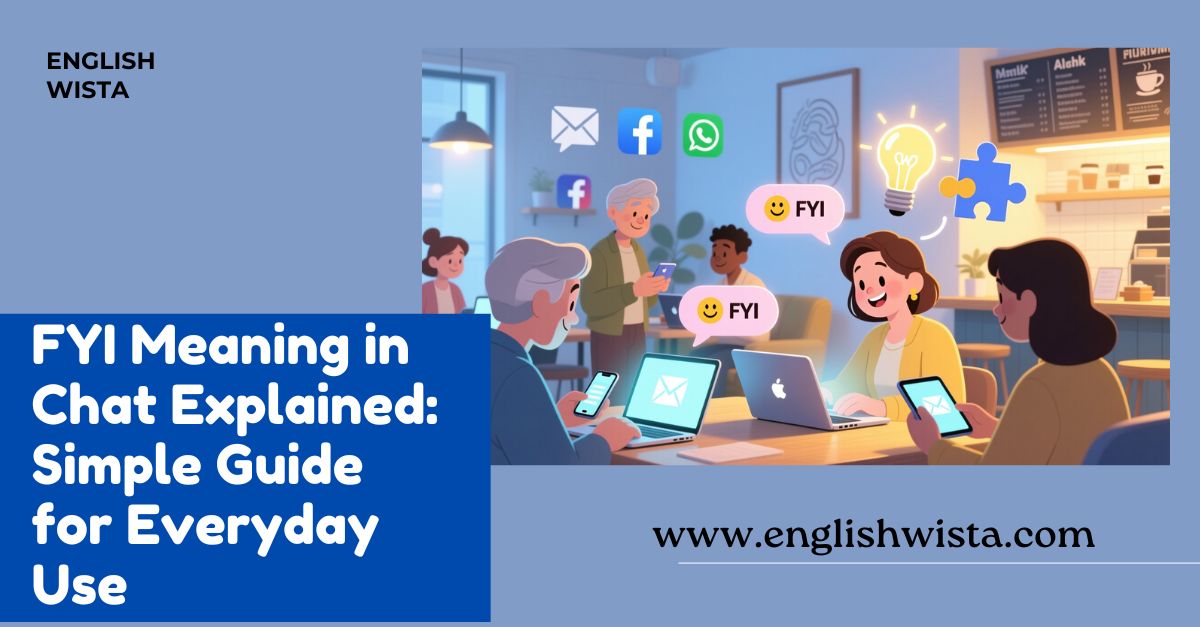Have you ever received a message from a friend, coworker, or classmate that simply said, “FYI”? At first glance, it looks like a random mix of letters, and you might wonder, What does that even mean? Don’t worry you’re not alone. Acronyms like this can feel confusing, especially in online conversations where people like to type fast and keep things short.
In this article, we’ll explore what FYI means in chat, where it comes from, and how you can use it naturally in everyday conversations. We’ll also look at examples, clear up common misunderstandings, and share a few fun facts to make this little acronym easy to remember. By the end, you’ll feel confident not only understanding FYI but also using it yourself.
Let’s dive in!
What Does FYI Mean?
The acronym FYI stands for “For Your Information.”
It’s a quick way of saying, “Here’s something you might want to know” or “Just letting you know.” Instead of typing the full phrase, people simply shorten it to three letters.
For example:
- FYI, the meeting starts at 3 PM.
- I sent you the file, FYI.
In both cases, the person isn’t asking for a reply. They’re just sharing helpful information.
Why Do People Use FYI in Chat?
Online chatting is all about speed. Typing long sentences takes time, so acronyms like FYI make communication faster and easier.
Here’s why people like using FYI:
- Saves time – Three letters are quicker than typing a whole sentence.
- Keeps things casual – It sounds light and informal.
- Adds clarity – It signals that what follows is just a heads-up, not a request.
Think of FYI as a little flag that says, This is useful, but you don’t have to respond.
Is FYI Polite or Rude?
This is a common question. Sometimes, people worry that FYI sounds cold or bossy. The truth is, it depends on tone and context.
- Polite use: FYI, the library closes at 7 tonight. (helpful reminder)
- Rude use: FYI, you did it wrong. (sounds critical)
The acronym itself is neutral. It becomes polite or rude based on the words and attitude surrounding it.
Tip: If you want to keep your FYI polite, add friendly words or emojis. For example:
- FYI 😊, the teacher changed the deadline.
- Just FYI, in case you didn’t see this.
How Do You Use FYI in Chat?
Using FYI is simple once you understand the basics.
Steps to use it naturally:
- Start with “FYI” at the beginning or middle of your sentence.
- Follow it with the information you want to share.
- Keep it short and clear.
Examples:
- FYI, the movie starts at 9, not 8.
- I’ll be late to dinner, FYI.
- Here’s the article you asked for, FYI.
You can also use it as a standalone message:
- FYI: Traffic is heavy today.
- FYI: The Wi-Fi might be down later.
Is FYI Formal or Informal?
FYI works in both casual chats and work messages, but the tone may change depending on where you use it.
- Casual Chat (friends/family):
- FYI, your favorite show has a new season!
- Workplace Chat (colleagues/boss):
- FYI, I updated the report this morning.
In a professional setting, FYI is common in emails, memos, and Slack messages. It helps people quickly share updates without sounding demanding.
Alternatives to FYI
Sometimes, you may want to switch things up. Here are a few alternatives that mean almost the same thing:
- Just so you know (JSYK) – Casual and friendly.
- For your reference (FYR) – More formal, often used at work.
- Heads up – Informal, like giving someone a quick warning.
- In case you missed it (ICYMI) – Often used on social media.
Example comparisons:
- FYI, the file is on the server.
- Just so you know, the file is on the server.
- Heads up, the file is on the server.
Each phrase carries a slightly different vibe, but they all share information.
Common Mistakes with FYI
Even though FYI is simple, people sometimes misuse it. Let’s look at a few common mistakes:
- Using it as a demand
- Wrong: FYI, you must finish this today.
- Better: Please finish this today. FYI, the deadline is close.
- Using it when a reply is needed
- Wrong: FYI, can you help me with this? (This needs a response, so FYI doesn’t fit well.)
- Better: Can you help me with this? FYI, the client needs it soon.
- Overusing it
- If every sentence starts with FYI, it can feel robotic or bossy. Use it sparingly.
Fun Facts About FYI
- Military Roots: FYI has been around since the early 20th century. It was first used in telegrams and military communications to share information quickly.
- Hollywood Spotlight: The phrase “For your information” became popular in movies and TV shows, making FYI more mainstream.
- Internet Age: With email and texting, FYI became a favorite shorthand for office workers. Now, it’s everywhere from group chats to social media posts.
- Not Just English: Other languages have their own versions of FYI. For example, in French, people might say “Pour info” (meaning “for information”).
FYI vs. Other Acronyms
The online world is full of acronyms. How does FYI compare with others?
- BTW (By the way): Similar to FYI but more casual.
- BTW, did you see the news?
- IMO (In my opinion): Shares personal thoughts, not just facts.
- IMO, that movie was great.
- ICYMI (In case you missed it): Specifically used when repeating information.
- ICYMI, the deadline changed.
Think of FYI as a neutral fact-sharing tool, while others express opinions or side notes.
Real-Life Scenarios with FYI
Here are a few everyday situations where you might use FYI:
- School or College
- FYI, the math class was moved to room 201.
- Workplace
- FYI, the manager will be visiting tomorrow.
- Friends and Family
- FYI, Mom already bought the cake.
- Social Media
- FYI: New episode drops tonight at 8!
- Travel
- FYI, the train is delayed by 20 minutes.
Notice how in all these cases, the goal is simply to share helpful information.
How to Reply to FYI
One nice thing about FYI is that you don’t always have to reply. But if you want to, here are a few easy responses:
- Got it, thanks!
- Thanks for the info.
- Okay, good to know.
- Appreciate the update.
Replies should be short and polite since FYI usually doesn’t require a big response.
Quick Recap of Key Points
- FYI = For Your Information.
- It’s used to share info, not to ask questions.
- Works in casual chats and professional settings.
- Can sound rude if used with harsh wording, so keep it friendly.
- Alternatives include just so you know, heads up, or ICYMI.
- Originated in telegrams and military use, then spread into everyday speech.
Conclusion
Now you know the meaning of FYI in chat and how to use it like a pro. It’s a small acronym, but it makes communication smoother, faster, and sometimes even friendlier. Whether you’re messaging friends, emailing coworkers, or posting online, FYI is a handy tool to keep in your vocabulary.
Just remember: keep it polite, don’t overuse it, and pair it with a smile (or emoji) when needed.
So next time someone texts you “FYI,” you’ll know exactly what they mean and you might even use it yourself. FYI, you’ve now mastered another piece of internet language!



